Temperature Dependence of the Resonant Magnetoelectric Effect in Layered Heterostructures
Abstract
:1. Introduction
2. Experimental
2.1. Samples
2.2. Methods of Measurement
3. Results and Discussion
3.1. Temperature Characteristics of Ferromagnetic and Piezoelectric Layers
3.2. Temperature Characteristics of the Linear Magnetoelectric Effect
3.3. Discussion of the Linear Magnetoelectric Effect
3.3.1. Temperature Dependence of the Resonance Frequency
- In structures with LGT layers and thin FM layers (Metglas or Ni), the resonance frequency weakly depends on the temperature, since the rigidity of the LGT layer insignificantly changes with the temperature (see Figure 3). In this case, an increase of the thickness of the Ni layer, where Y decreases with growing temperature, leads to an increase of the relative contribution of Ni to the effective Young’s modulus and to the corresponding decrease in the resonance frequency. This is the case in the experiment (Figure 11a).
- In structures with PZT layers, the reduction of the resonant frequency with growing temperature (see Figure 12) is due to a decrease of the Young’s modulus of the PZT layer (see Figure 2). In this case, the largest reduction of the resonance frequency by 6% occurs in the structure with a thick layer of Ni, whose Young’s modulus also decreases with increasing temperature.
- The growth of the Young’s modulus of the langatate crystal in the temperature range between 200 and 320 K (see Figure 2) allows one to design composite structures with a vanishing temperature coefficient of frequency at room temperature. This can be achieved by the optimal selection of the thickness of the LGT layer and the FM layer, where YFM decreases with increasing temperature. Such an optimization can be used for thermal stabilization of prospective ME devices.
3.3.2. Temperature Dependence of the Quality Factor
- In structures with LGT layers and a thin FM layer, when bp >> bm, the behavior of the Q(T)-dependence is determined by the PE layer, and the monotonic decrease in the quality factor with increasing temperature is caused by reduction of the mechanical quality factor of the langatate. For the LGT-Ni_T structure, the effect of a thick nickel layer, whose quality factor declines with the increasing temperature by a factor of 2, leads to a general reduction of the total quality factor in comparison to the LGT-Ni structure. Further, the loss of the total quality factor is pronounced more clearly with heating, since the quality factor of both layers decreases.
- The quality factor of structures with ceramic PZT layers is low and is determined by the small quality factor Qp ≈ 100 of the PZT layer. In PZT structures with thin FM layers, the quality factor should remain approximately constant over the entire temperature range, since both the quality factor and the Young’s modulus of the PZT layer depend weakly on the temperature (see Figure 2 and Figure 3). This expectation is confirmed by the experiment. In the low-temperature range, the quality factor of PZT structures with a thick nickel layer grows with increasing temperature because of the increase in the quality factor of the Ni layer.
3.3.3. Temperature Dependence of the Magnetoelectric Coefficient
- For structures comprising LGT layers, whose PE modulus d11 and dielectric permittivity ε11 vary by 20% [29,31] and the quality factor Q is reduced threefold in the investigated temperature range, the acoustic quality factor of the entire structure plays crucial role in the temperature dependence of the ME coefficient. The thickening of the Ni layer in the LGT-Ni composite structure leads to an additional decrease in the quality factor and, consequently, to a stronger reduction the ME coefficient with increasing temperature. The smallest influence on the temperature dependence of α′E(T) is exercised by the piezomagnetic coefficient λ(1) of a Ni or Metglas layer, which is a constitutive part of the structure.
- For structures comprising PZT layers, the particular form of the α′E(T)-dependence occurs as a result of competition of several effects. With an increase of temperature from 200 to 400 K, the dielectric constant ε of a PZT layer increases fourfold (see Figure 4), which should lead to a significant decrease of the ME signal. However, this is compensated by a threefold increase of the PE modulus d31 of PZT. As a result, the ratio d31/ε can only decrease by approximately 25% with increasing temperature. The quality factor of the PZT layer depends weakly on the temperature (see Figure 3). In this case, the behavior of the temperature dependence of the resonance ME coefficient of the PZT-Metglas structure will be determined by the temperature dependence of the piezomagnetic modulus λ(1) of the FM layer. Indeed, the shapes of the curves α′(T) in Figure 13b and λ(1)(T) in Figure 10 are qualitatively the same. Similarly, for the PZT-Ni structure, the dependence of α′(T) is determined by the competition between two processes: a monotonic decrease of d31/ε with increasing temperature and a linear growth of λ(1)(T) for Ni (see Figure 11). The higher thermal stability of the ME coefficient of the PZT-Ni_T at temperatures T exceeding 320 K, in comparison with the PZT-Ni structure (Figure 3), can be explained by the growing contribution of the piezomagnetic modulus due to the larger thickness of the FM layer.
4. Temperature Characteristics of the Nonlinear Magnetoelectric Effect
5.Conclusions
Acknowledgments
Author Contributions
Conflicts of Interest
References
- Nan, C.-W.; Bichurin, M.I.; Dong, S.; Viehland, D.; Srinivasan, G. Multiferroic magnetoelectric composites: Historical perspective, status, and future directions. J. Appl. Phys. 2008, 103, 031101. [Google Scholar] [CrossRef]
- Van Suchtelen, J. Product properties: A New Application of Composite Materials. Philips Res. Rep. 1972, 27, 28–37. [Google Scholar]
- Palneedi, H.; Annapureddy, V.; Priya, S.; Ryu, J. Status and perspectives of multiferroic magnetoelectric composite materials and applications. Actuators 2016, 5, 9. [Google Scholar] [CrossRef]
- Hu, J.-M.; Chen, L.-Q.; Nan, C.-W. Multiferroic heterostructures integrating ferroelectric and magnetic materials. Adv. Mater. 2016, 28, 15–39. [Google Scholar] [CrossRef] [PubMed]
- Vopson, M. Fundamentals of multiferroic materials and their possible applications. Crit. Rev. Solid State Mater. Sci. 2015, 40, 223–250. [Google Scholar] [CrossRef] [Green Version]
- Maraushka, S.; Jahns, R.; Greve, H.; Quandt, E.; Knochel, R.; Wagner, B. MEMS magnetic field sensor based on magnetoelectric composites. J. Micromech. Microeng. 2012, 22, 065024. [Google Scholar] [CrossRef]
- Wang, Y.; Li, J.; Viehland, D. Magnetoelectrics for magnetic sensor applications: Status, challenges and perspectives. Mater. Today 2014, 17, 269–275. [Google Scholar] [CrossRef]
- Srinivasan, G.; Fetisov, Y.K. Ferrite-piezoelectric layered structures: Microwave magnetoelectric effects and electric field tunable devices. Ferroelectrics 2006, 342, 65–71. [Google Scholar] [CrossRef]
- Peng, B.; Zhang, C.; Yan, Y.; Liu, M. Voltage-Impulse-Induced Nonvolatile Control of Inductance in Tunable Magnetoelectric Inductors. Phys. Rev. Appl. 2017, 7, 044015. [Google Scholar] [CrossRef]
- Liu, M.; Sun, N.X. Voltage control of magnetism in multiferroic heterostructures. Philos. Trans. R. Soc. A 2014, 372, 20120439. [Google Scholar] [CrossRef] [PubMed]
- Ma, J.; Hu, J.; Li, Z.; Nan, C.-W. Recent Progress in Multiferroic Magnetoelectric Composites: From Bulk to Thin Films. Adv. Matter. 2011, 23, 1062–1087. [Google Scholar] [CrossRef] [PubMed]
- Shen, J.; Cong, J.; Chai, Y.; Shang, D.; Shen, S.; Zhai, K.; Tian, Y.; Sun, Y. A non-volatile memory based on nonlinear magnetoelectric effects. Phys. Rev. Appl. 2016, 6, 021001. [Google Scholar] [CrossRef]
- Shen, J.; Shang, D.; Chai, Y.; Wang, Y.; Cong, J.; Shen, S.; Yan, L.; Wang, W.; Sun, Y. Nonvolatile Multilevel Memory and Boolean Logic Gates Based on a Single Ni/[Pb(Mg1/3Nb2/3)O3]0.7[PbTiO3]0.3/Ni Heterostructure. Phys. Rev. Appl. 2016, 6, 064028. [Google Scholar] [CrossRef]
- Kim, S.B.; Park, J.H.; Ahn, H.; Liu, D.; Kim, D.J. Temperature effects on output power of piezoelectric vibration energy harvesters. Microelectr. J. 2011, 42, 988–991. [Google Scholar] [CrossRef]
- Mostovoy, M.; Scaramucci, A.; Spaldin, N.A.; Delaney, K.T. Temperature-dependent magnetoelectric effect from first principles. Phys. Rev. Lett. 2010, 105, 087202. [Google Scholar] [CrossRef] [PubMed]
- Zhang, N.; Srinivasan, G.; Balbashov, A.M. Low-frequency magnetoelectric interactions in single crystal and polycrystalline bilayters of lanthanum strontium manganite and lead zirconate titanate. J. Mater. Sci. 2009, 44, 5120. [Google Scholar] [CrossRef]
- Li, T.; Wang, H.; Hu, Z.; Li, K. Temperature dependence of magnetoelectric coupling in La0.7Sr0.3MnO3/BaTiO3 layered heterostructure with various volume fractions. Thin Solid Films 2016, 616, 1–5. [Google Scholar] [CrossRef]
- Vaz, C.A.F.; Segal, Y.; Hoffman, J.; Grober, R.D.; Walker, F.J.; Ahn, C.H. Temperature dependence of the magnetoelectric effect in Pb(Zr0.2Ti0.8)O3/La0.8Sr0.2MnO3 multiferroic heterostructures. Appl. Phys. Lett. 2010, 97, 042506. [Google Scholar] [CrossRef]
- Fang, F.; Xu, Y.T.; Yang, W. Magnetoelectric coupling of laminated composites under combined thermal and magnetic loadings. J. Appl. Phys. 2012, 111, 023906. [Google Scholar] [CrossRef]
- Gutierrez, J.; Lasheras, A.; Barandiaran, J.M.; Vilas, J.L. Temperature response of magnetostrictive/piezoelectric polymer magnetoelectric laminates. Key Eng. Mater. 2011, 495, 351–354. [Google Scholar] [CrossRef]
- Burdin, D.A.; Fetisov, Y.K.; Chashin, D.V.; Ekonomov, N.A. Temperature dependence of the characteristics of the resonant magnetoelectric effect in a lead magnesium niobate—Lead titanate/nickel structure. Tech. Phys. Lett. 2012, 38, 6610664. [Google Scholar] [CrossRef]
- Burdin, D.A.; Fetisov, Y.K.; Chashin, D.V.; Segalla, A.G.; Srinivasan, G. Multiferroic bending mode resonators and studies on temperature dependence of magnetoelectric interactions. Appl. Phys. Lett. 2012, 100, 242902. [Google Scholar] [CrossRef]
- Burdin, D.A.; Fetisov, Y.K.; Chashin, D.V.; Ekonomov, N.A. Temperature behavior of magnetoelectric interaction in composite PZT-Nickel disk resonators. Tech. Phys. 2013, 58, 414–419. [Google Scholar] [CrossRef]
- Burdin, D.; Chashin, D.; Ekonomov, N.; Fetisov, Y. Temperature Characteristics of Magnetoelectric Effect in Bilayer Ferromagnetic-Piezoelectric Structures. Solid State Phenom. 2015, 233–234, 357–359. [Google Scholar] [CrossRef]
- Ye, J.X.; Ma, J.N.; Hu, J.M.; Li, Z.; Feng, M.; Zhang, Q.M.; Nan, C.-W. Temperature dependence of magnetoelectric coupling in FeBSiC/PZT/FeBSiC laminates. J. Appl. Phys. 2014, 116, 074103. [Google Scholar] [CrossRef]
- Zhang, J.; Gao, Y. Effects of hysteresis and temperature on magnetoelectric effect in giant magnetostrictive/piezoelectric composites. Int. J. Solids Struct. 2015, 69, 291–304. [Google Scholar] [CrossRef]
- Israel, C.; Kar-Narayan, S.; Mathor, N.D. Eliminating temperature dependence of the response of magnetoelectric magnetic-fiels sensors. IEEE Sens. J. 2010, 10, 914–917. [Google Scholar] [CrossRef]
- Shen, Y.; Gao, J.; Wang, Y.; Li, J.; Viehland, D. Thermal stability of magnetoelectric sensors. Appl. Phys. Lett. 2012, 100, 173505. [Google Scholar] [CrossRef]
- ELPA R&P. Available online: http://www.elpapiezo.ru (accessed on 11 October 2017).
- FOMOS-Materials. Piezoelectric Materials and Devices. Available online: http://newpiezo.com (accessed on 11 October 2017).
- Sreenivasulu, G.; Fetisov, L.Y.; Fetisov, Y.K.; Srinivasan, G. Piezoelectric single crystal langatate and ferromagnetic composites: studies on low-frequency and resonance magnetoelectric effects. Appl. Phys. Lett. 2012, 100, 052901. [Google Scholar] [CrossRef]
- Metglas, Inc. Available online: http://www.metglas.com (accessed on 11 October 2017).
- Jaffe, B.; Cook, W.R.; Jaffe, H.L. Piezoelectric Ceramics; Academic Press: London, UK; New York, NY, USA, 1971; p. 317. [Google Scholar]
- Timoshenko, S.P. Vibration Problems in Engineering; Wiley: New York, NY, USA, 1974. [Google Scholar]
- Kikuchi, Y. Ultrasonic Transducers; Kikuchi, Y., Ed.; Corona Publishing Co. Ltd.: Tokyo, Japan, 1969. [Google Scholar]
- Davulis, P.; Sturtevant, B.T.; Duy, S.L.; da Cunha, M.P. Revisiting LGT dielectric constants and temperature coefficients up to 120 °C. Proc. IEEE Ultrason. Symp. 2007, 1397–1400. [Google Scholar] [CrossRef]
- Miclea, C.; Tanasoiu, C.; Amarande, L.; Miclea, C.F.; Plavitu, C.; Cioangher, M.; Trupina, L.; Miclea, C.T.; David, C. Effect of Temperature on the main piezoelectric parameters of a soft PZT ceramic. Rom. J. Inf. Sci. Technol. 2007, 10, 243–250. [Google Scholar]
- Davulis, P.M. Characterization of the Elastic, Piezoelectric, and Dielectric Properties of Langatate at High Temperatures Up To 900 °C. Ph.D. Thesis, The University of Maine, Orono, ME, USA, 2013. [Google Scholar]
- Li, F.; Xu, Z.; Wei, X.; Yao, X. Determination of temperature dependence of piezoelectric coefficients matrix of lead zirconate titanate ceramics by quasi-static and resonance method. J. Phys. D Appl. Phys. 2009, 42, 095417. [Google Scholar] [CrossRef]
- Burdin, D.A.; Chashin, D.V.; Ekonomov, N.A.; Fetisov, L.Y.; Fetisov, Y.K.; Srinivasan, G.; Sreeniasulu, G. Nonlinear magnetoelectric effects in planar ferromagnetic-piezoelectric structures. J. Magn. Magn. Mater. 2014, 358–359, 98–104. [Google Scholar] [CrossRef]
- Fetisov, Y.K.; Chashin, D.V.; Ekonomov, N.A.; Burdin, D.A.; Fetisov, L.Y. Correlation between magnetoelectric and magnetic properties of ferromagnetic-piezoelectric structures. IEEE Trans. Magn. 2015, 51, 1–3. [Google Scholar] [CrossRef]
- Liu, B.; Feng, X.; Zhang, S.M. The effective Young’s modulus of composites beyond the Voigt estimation due to the Poisson effect. Compos. Sci. Technol. 2009, 69, 2198–2204. [Google Scholar] [CrossRef]
- Bichurin, M.I.; Petrov, V.M.; Srinivasan, G. Theory of low-frequency magnetoelectric coupling in magnetostrictive-piezoelectric bilayers. Phys. Rev. B 2003, 68, 054402. [Google Scholar] [CrossRef]
- Bush, A.A.; Kamentsev, K.E.; Meshcheryakov, V.F.; Fetisov, Y.K.; Chashin, D.V.; Fetisov, L.Y. Low-frequency magnetoelectric effect in a Galfenol-PZT planar composite structure. Tech. Phys. 2009, 54, 1314–1320. [Google Scholar] [CrossRef]
- Burdin, D.; Chashin, D.; Ekonomov, N.; Fetisov, L.; Fetisov, Y.; Shamonin, M. DC magnetic field sensing based on the nonlinear magnetoelectric effect in magnetic heterostructures. J. Phys. D Appl. Phys. 2016, 49, 375002. [Google Scholar] [CrossRef]
- Lasheras, A.; Gutiérrez, J.; Reis, S.; Sousa, D.; Silva, M.; Martins, P.; Lanceros-Mendez, S.; Barandiarán, J.M.; Shishkin, D.A.; Potapov, A.P. Energy harvesting device based on a metallic glass/PVDF magnetoelectric laminated composite. Smart Mater. Struct. 2015, 24, 065024. [Google Scholar] [CrossRef]

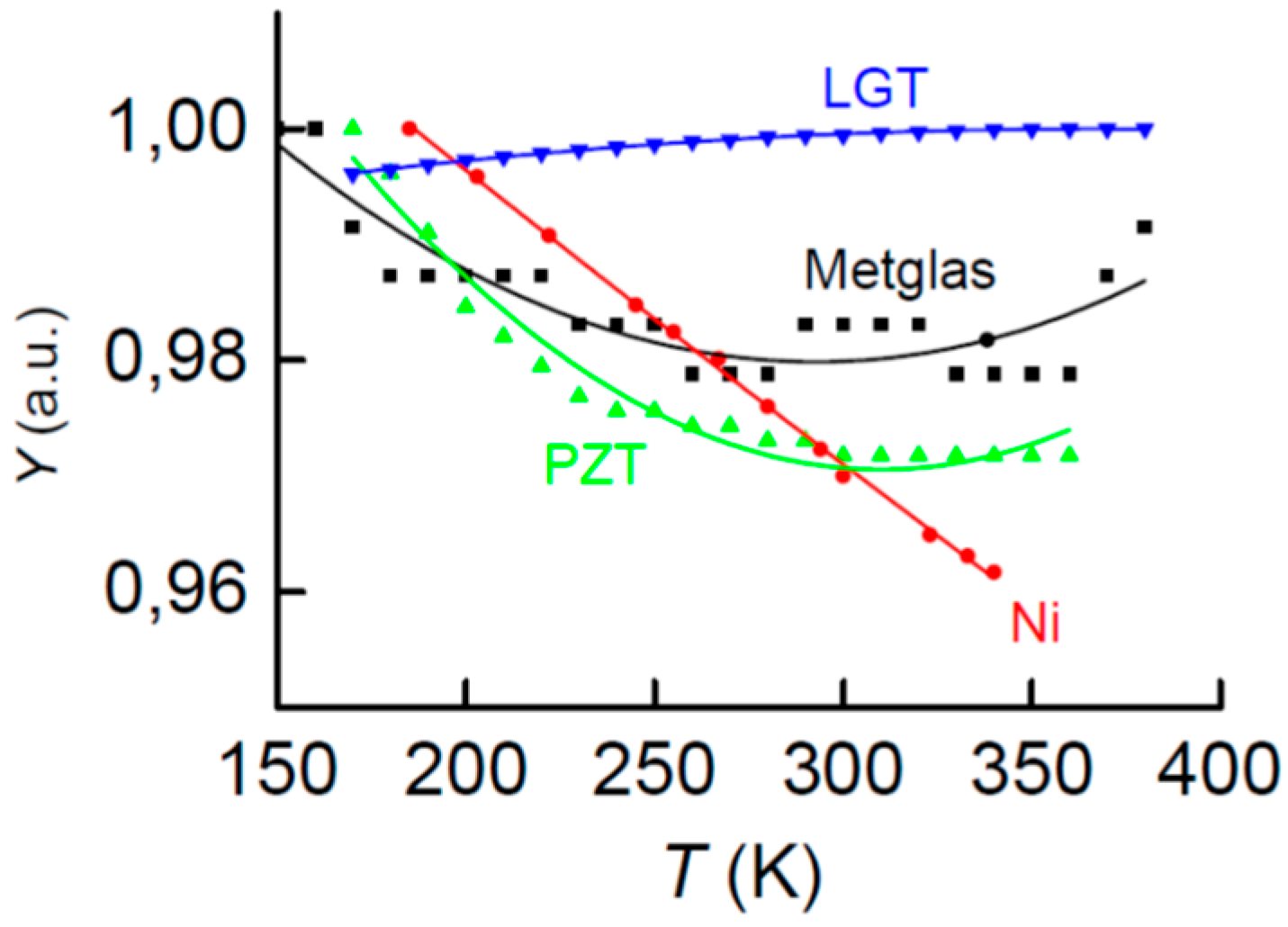



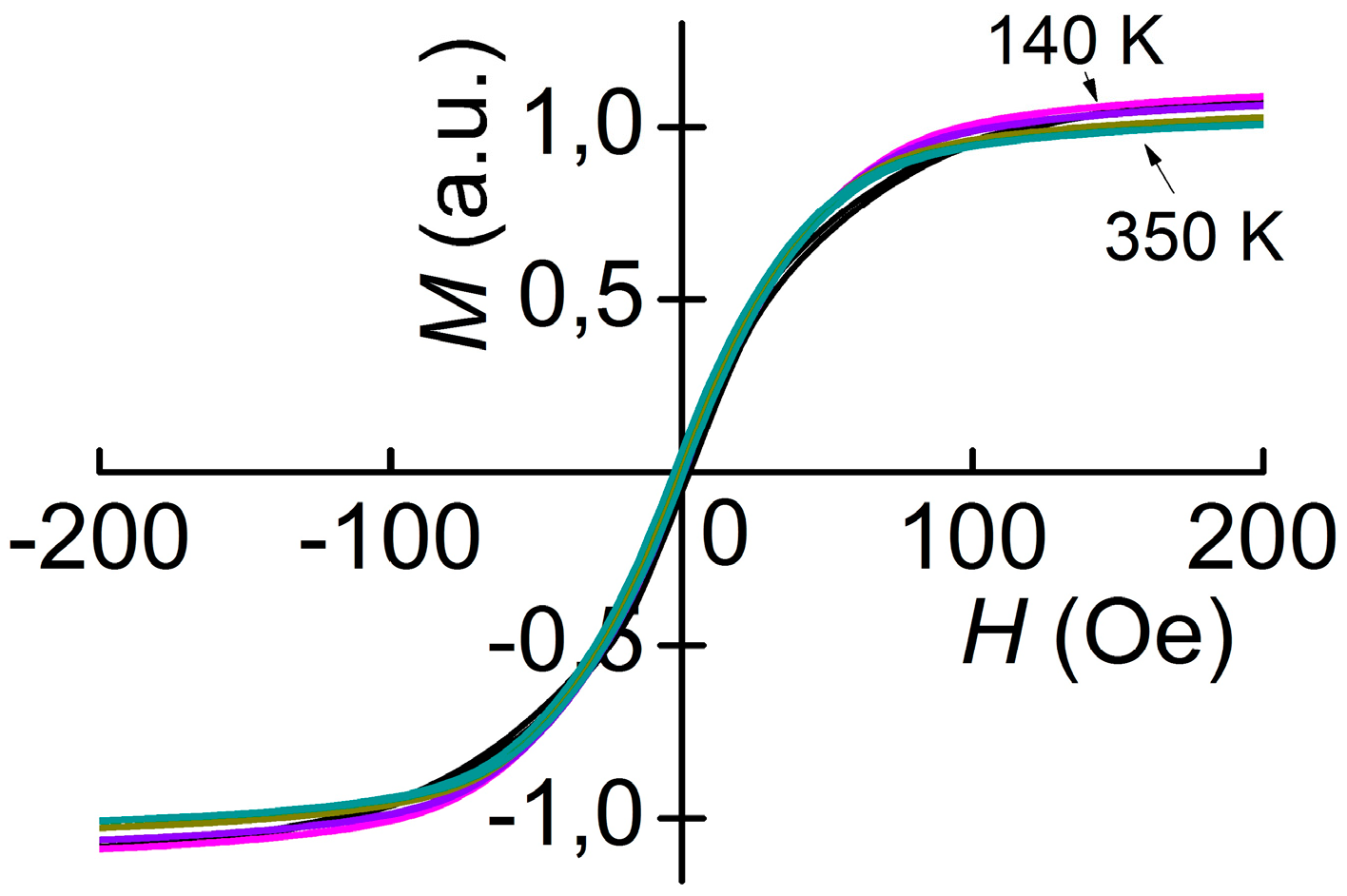


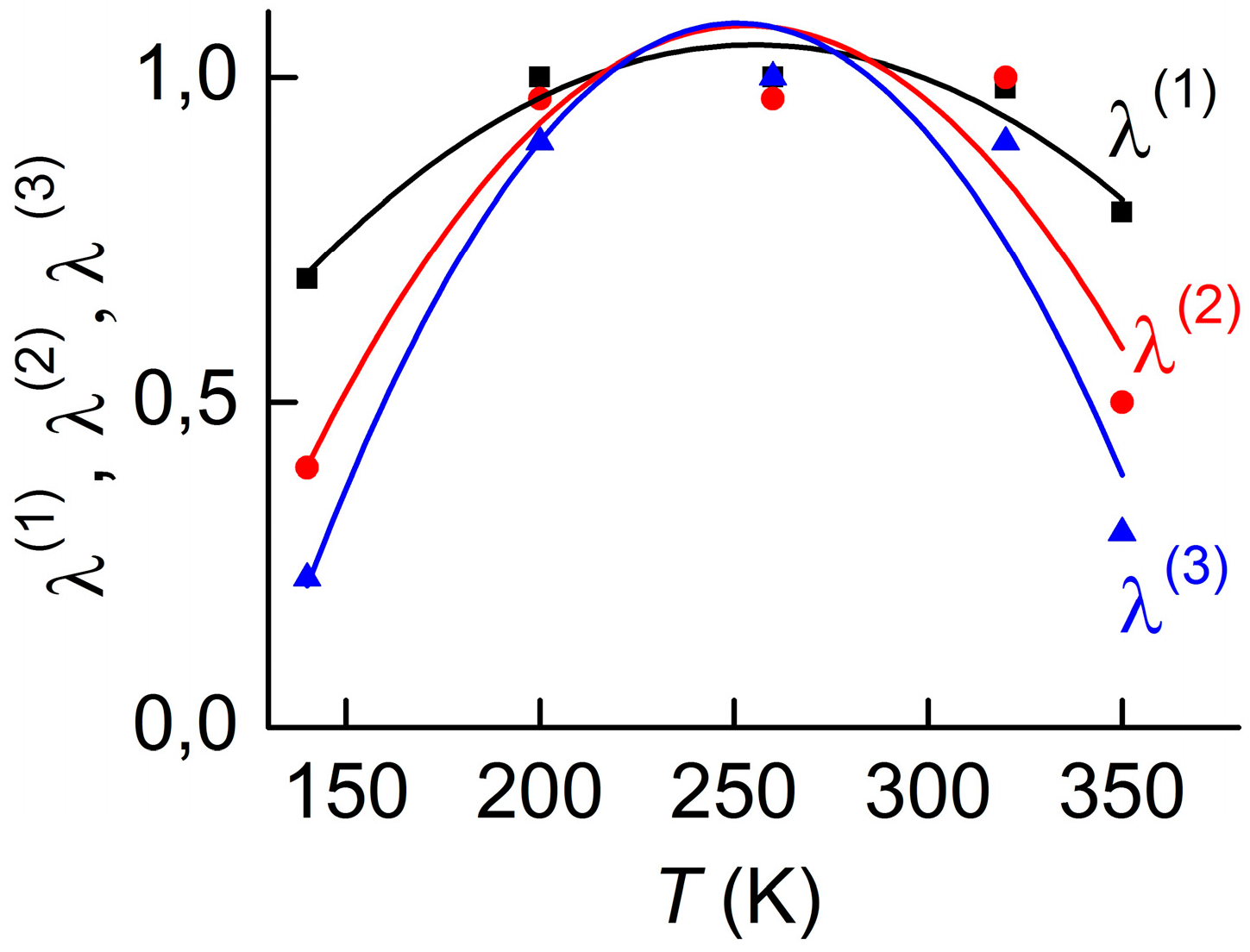
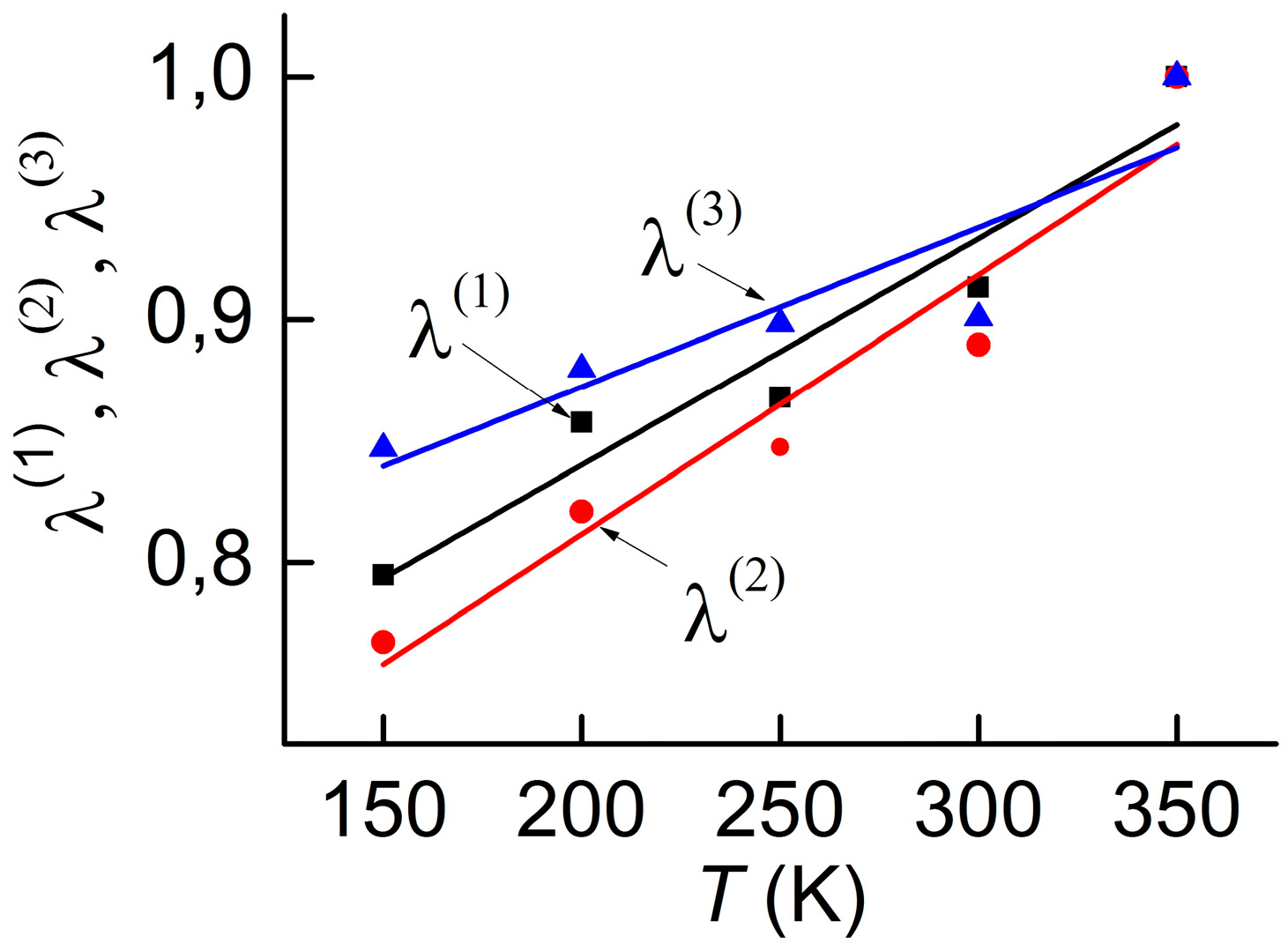
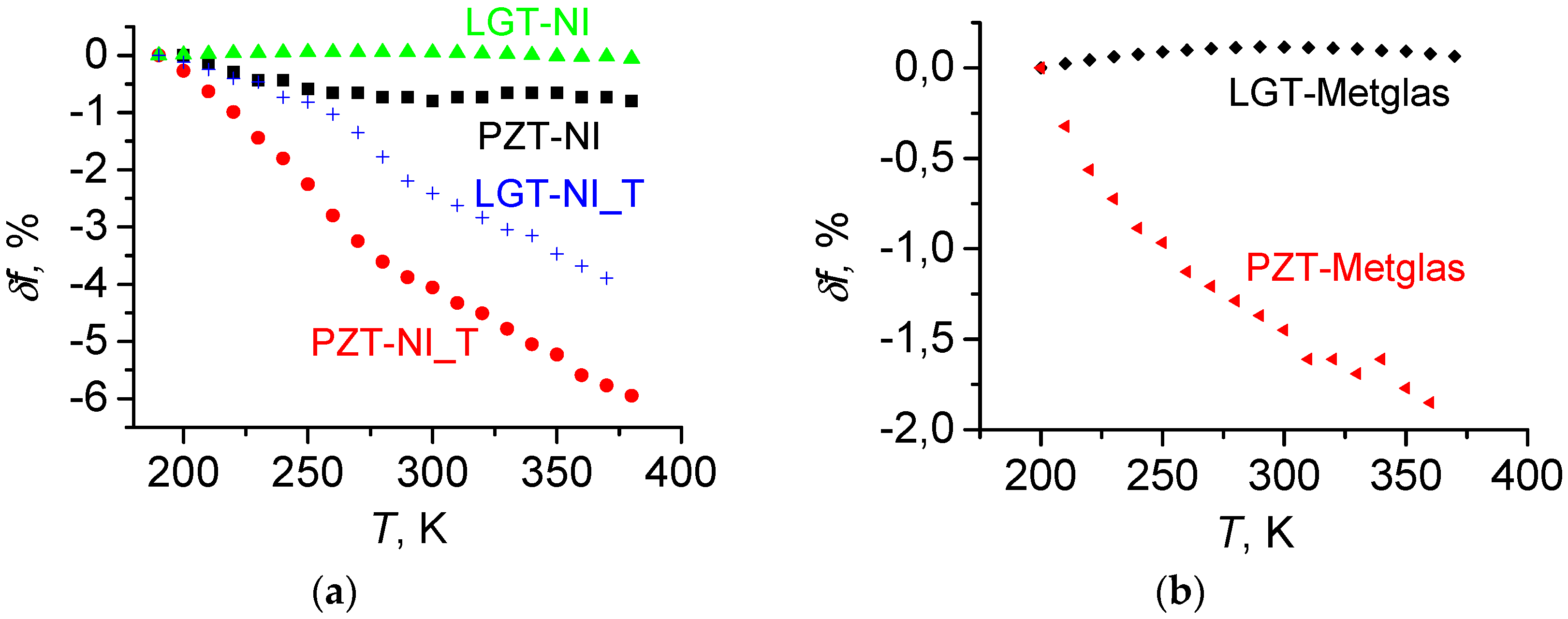


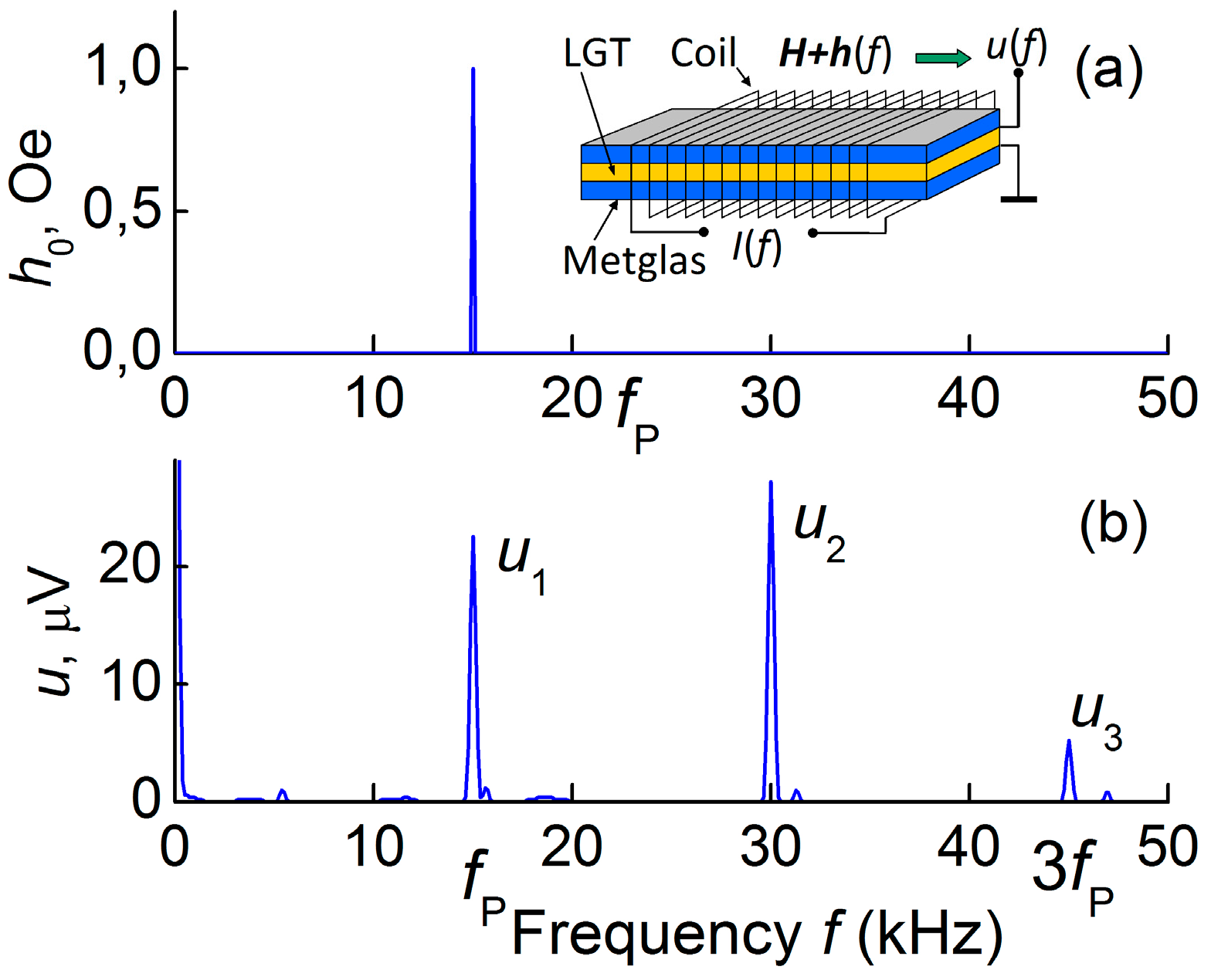
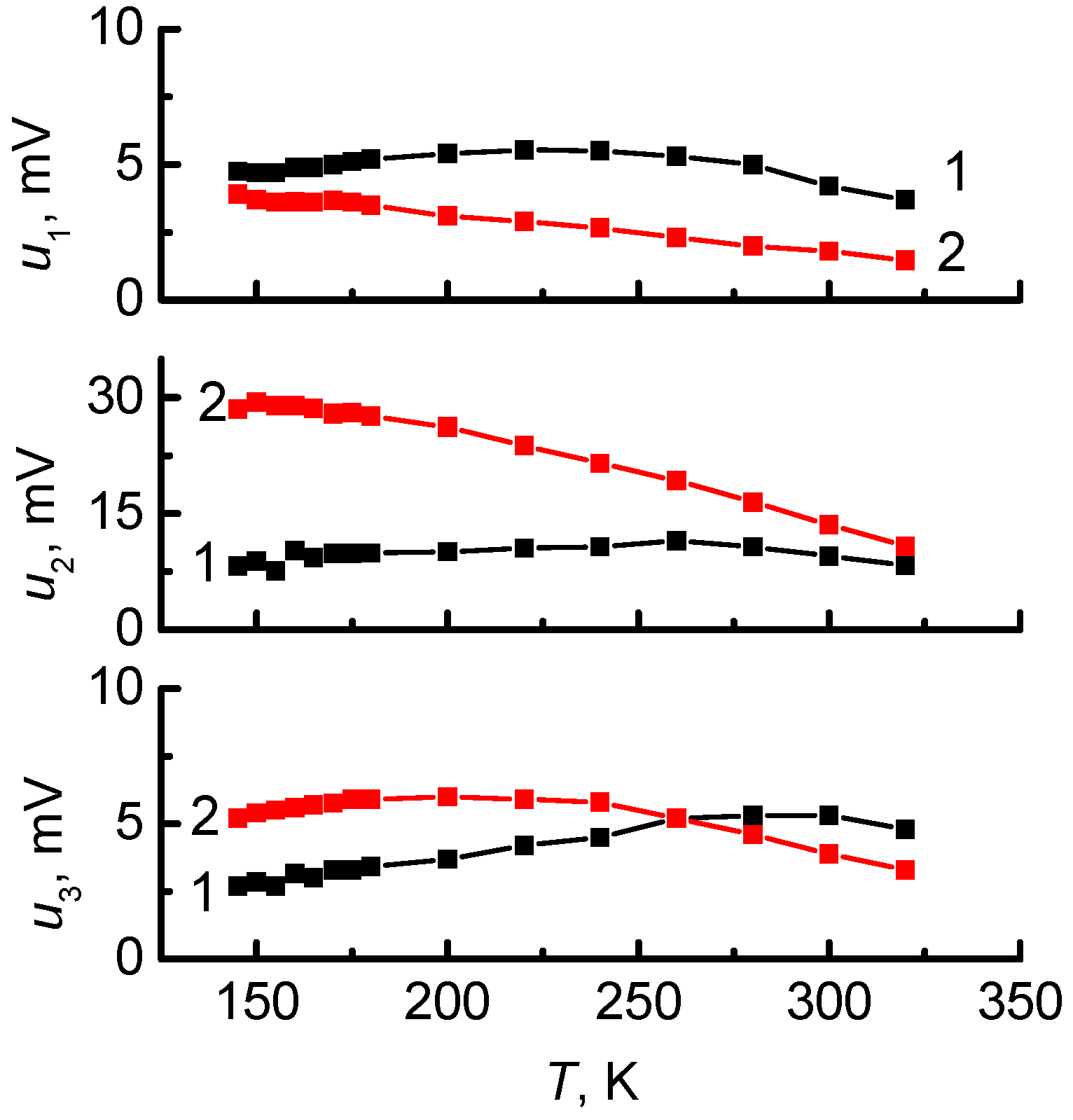
| Material’s Notation | PZT-5 | LGT | Ni | Metglas 2605S3A |
|---|---|---|---|---|
| Chemical composition | (Pb0.95Sr0.05) (Zr0.53Ti0.47)O | La3Ga5.5Ta0.5O14 | Ni | FeBSiC |
| Mechanical quality factor, Q | 90 | 10000 | 100 | 75 |
| Young’s modulus, Y (1010 Pa) | 6.2 | 26 | 20 | 10 |
| Relative dielectric permittivity, ε | 1100 | 20 | ||
| PE coefficient, d (pC/N) | d31 = 200 | d11 = 5.1, d14 = 4.7 | ||
| Saturation magnetostriction, λS × 106 | −30 | 20 | ||
| Saturation field, HS (Oe) | ~500 | ~60 |
| Sample | Thickness of FM Layer, (µm) | Thickness of PE Layer, (µm) | Length × Width, (mm × mm) | |
|---|---|---|---|---|
| No. | Composition | |||
| 1 | LGT-Metglas | 20 | 500 | 20 × 5 |
| 2 | LGT-Ni | 50 | 500 | 20 × 5 |
| 3 | PZT-Metglas | 20 | 450 | 20 × 5 |
| 4 | PZT-Ni | 50 | 450 | 20 × 5 |
| 5 | PZT-Ni_T | 200 | 450 | 20 × 5 |
| 6 | LGT-Ni_T | 200 | 500 | 20 × 5 |
| Sample | fr (kHz) | Q | αE (V/cm × Oe) |
|---|---|---|---|
| LGT-Metglas | 83.5 | 6000 | 450 |
| LGT-Ni | 84.2 | 5000 | 45.5 |
| PZT-Metglas | 62 | 120 | 135 |
| PZT-Ni | 65 | 100 | 3.0 |
| PZT-Ni_T | 111 | 110 | 10 |
| LGT-Ni_T | 94 | 170 | 10 |
© 2017 by the authors. Licensee MDPI, Basel, Switzerland. This article is an open access article distributed under the terms and conditions of the Creative Commons Attribution (CC BY) license (http://creativecommons.org/licenses/by/4.0/).
Share and Cite
Burdin, D.A.; Ekonomov, N.A.; Chashin, D.V.; Fetisov, L.Y.; Fetisov, Y.K.; Shamonin, M. Temperature Dependence of the Resonant Magnetoelectric Effect in Layered Heterostructures. Materials 2017, 10, 1183. https://doi.org/10.3390/ma10101183
Burdin DA, Ekonomov NA, Chashin DV, Fetisov LY, Fetisov YK, Shamonin M. Temperature Dependence of the Resonant Magnetoelectric Effect in Layered Heterostructures. Materials. 2017; 10(10):1183. https://doi.org/10.3390/ma10101183
Chicago/Turabian StyleBurdin, Dmitrii A., Nikolai A. Ekonomov, Dmitrii V. Chashin, Leonid Y. Fetisov, Yuri K. Fetisov, and Mikhail Shamonin. 2017. "Temperature Dependence of the Resonant Magnetoelectric Effect in Layered Heterostructures" Materials 10, no. 10: 1183. https://doi.org/10.3390/ma10101183





